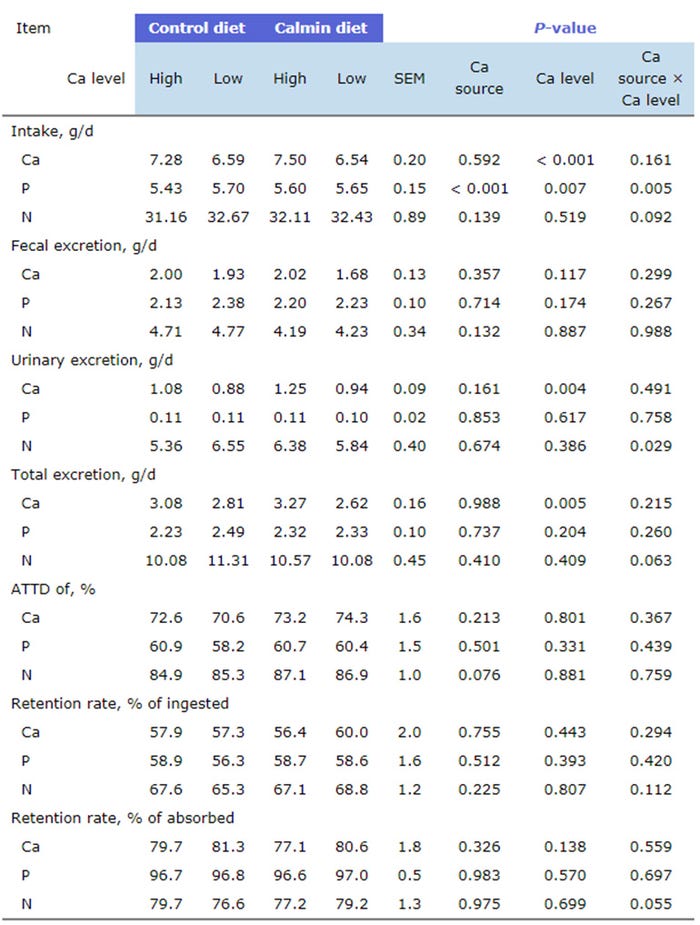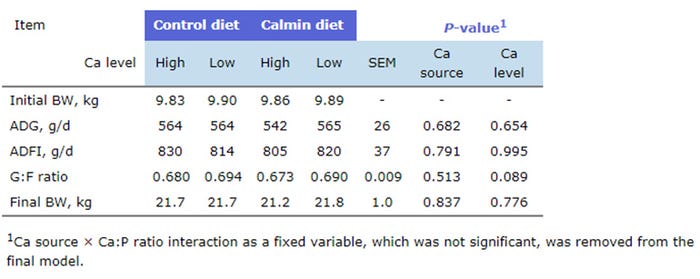Weanling pigs perform just fine with calcium supplement
Digestible energy is greater in Calmin-containing diets compared with diets containing the same level of calcium without Calmin.
January 2, 2018

Source: University of Illinois Hans H. Stein Monogastric Nutrition Laboratory
Calmin is a calcium supplement produced from sea minerals. It also contains 6% magnesium, which may increase calcium absorption. Calmin has been used as a rumen buffer in dairy cows, but limited data are available for pigs. Therefore, two experiments were conducted to test the effect of feeding diets containing Calmin on calcium, phosphorus and nitrogen balance, energy balance and growth performance of weanling pigs.
Experiments
Four diets were formulated for each experiment: low- and high-calcium control diets, and low- and high-calcium Calmin diets. The control diets were based on corn, soybean meal, monocalcium phosphate and limestone, with magnesium oxide added. The Calmin diets contained 0.40% Calmin at the expense of limestone, and no added magnesium oxide. The standardized total tract digestible calcium:phosphorus ratio (STTD Ca:STTD P) was 1.38:1 in the low-calcium diets and 1.57:1 in the high-calcium diets.
To study energy and nutrient balance, a total of 32 barrows with an average initial body weight of 19.5 kilograms were allotted to one of the four diets. Feed intake was monitored and recorded. Urine and feces were collected for five days and analyzed to determine excretion, retention and apparent total tract digestibility of calcium, phosphorus and nitrogen, as well as ATTD of energy.
To study growth performance, a total of 128 pigs were allotted to the four experimental diets on Day 14 post-weaning, when their average initial body weight was 9.9 kilograms. Feed intake was monitored and recorded, and pig weights were recorded at the beginning and at the end of the 21-day experimental period.
Key points
• Digestible energy is greater in Calmin-containing diets compared with diets containing the same level of calcium without Calmin.
• Pigs had greater phosphorus intake when fed high-calcium Calmin diets than when fed high-calcium control diets, but otherwise the calcium source did not affect calcium, phosphorus or nitrogen balance.
• Feeding diets containing Calmin had no negative impact on growth performance in weanling pigs.
Energy and nutrient balance
There was no difference among pigs fed any of the four experimental diets in feed intake, gross energy intake, fecal or urinary energy excretion, or ATTD of dry matter (Table 1). The ATTD of gross energy and the concentration of digestible energy were greater (P < 0.05) in pigs fed diets containing Calmin. There was also a tendency (P = 0.096) for metabolizable energy concentration to be greater in Calmin-containing diets than in control diets.

Table 1: Energy digestibility and retention in pigs fed experimental diets (as-fed basis)
Intake, urinary excretion and total excretion of calcium were greater (P < 0.05) in pigs fed the high-calcium diets than pigs fed the low-calcium diets (Table 2). Phosphorus intake was greater (P < 0.05) in pigs fed the low-calcium control diet than the high-calcium control diet, and also greater (P < 0.05) in pigs fed the high-calcium Calmin diet than the high-calcium control diet.

Table 2: Digestibility and retention rate of Ca, P, and N in pigs fed experimental diets
On all other measures of intake, excretion, ATTD and retention of calcium, phosphorus and nitrogen, no difference was observed among pigs fed the four diets.
Growth performance
The interaction between calcium source and Ca:P ratio was not significant for any response criteria.

Table 3: Growth performance from growing pigs fed experimental diets
Average daily gain, average daily feed intake, gain:feed ratio and final body weight did not differ among pigs fed the four diets. However, there was a tendency for gain:feed to be greater (P = 0.089) in pigs fed the low-calcium diets than in pigs fed the high-calcium diets.
This report is based on unpublished research by Su A Lee and Hans H. Stein.
You May Also Like



